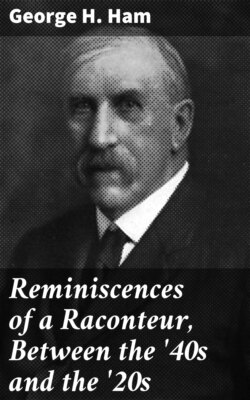Читать книгу Reminiscences of a Raconteur, Between the '40s and the '20s - George H. Ham - Страница 27
На сайте Литреса книга снята с продажи.
The First Iron Horse
ОглавлениеTable of Contents
The arrival of the first locomotive in Winnipeg was a red-letter day for the whole Canadian West. It was on October 9, 1877. Brought down the Red River on a barge, with six flat cars and a caboose, towed by the old Kittson Line stern-wheeler, Selkirk, her voyage down stream was one continuous triumphal progress from Pembina at the International boundary to Winnipeg.
The Free Press of that day, on whose staff I was city editor, telegraph editor, news editor, reporter, proof reader and exchange editor, gave the following account from its Pembina correspondent of the eventful affair:
“The steamer Selkirk arrived at Pembina yesterday (Sunday), with three barges, having on board a locomotive and tender, a caboose and six platform cars, in charge of Mr. Joseph Whitehead, contractor on the C.P.R. As this is the pioneer locomotive making its way down the Red River Valley, the steamer was hailed by the settlers with the wildest excitement and greatest enthusiasm, especially as Mr. Whitehead had steam up on his engine, and notified the inhabitants that the iron horse was coming by the most frantic shrieks and snortings. On passing Fort Pembina the flotilla was saluted by the guns of the (U.S.) artillery, and upon arrival at Pembina it was met by Captain McNaught, commanding at Fort Pembina, and his officers, Hon. J. Frankenfield, N. E. Nelson, and his associates in the U. S. customs, and the population en masse. The flotilla was handsomely decorated with flags and bunting, proud of the high distinction of carrying the first locomotive destined to create a new era for travel and traffic in the great northwest.”
The Free Press said in part on October 9th:
“At an early hour this morning, wild, unearthly shrieks from the river announced the coming of the steamer Selkirk, with the first locomotive ever brought into Manitoba; and about 9 o’clock the boat steamed past the Assiniboine. A large crowd of people collected upon the river banks, and, as the steamer swept past the city, mill whistles blew furiously, and bells rang out to welcome the iron horse. By this time the concourse had assembled at No. 6 warehouse (at foot of Lombard street) where the boat landed, and in the crowd were to be noticed people of many different nationalities represented in the prairie provinces.
“The Selkirk was handsomely decorated for the occasion with Union Jacks, Stars and Stripes, banners with the familiar ‘C.P.R.’ and her own bunting; and with the barge conveying the locomotive and cars ahead of her, also gaily decorated with flags and evergreens and a barge laden with railway ties on each side presented a novel spectacle. The whistles of the locomotive and the boat continued shrieking, the mill whistles joined in the chorus, the bells clanged—a young lady, Miss Racine, pulling manfully at the ropes—and the continuous noise and din proclaimed loudly that the iron horse had arrived at last. Shortly after landing three cheers were given for Mr. Joseph Whitehead, and in a few minutes a crowd swarmed on board and examined the engine most minutely. The caboose and flat cars, which also came in for their share of attention, each bearing the name ‘Canadian Pacific’ in white letters. After remaining a couple of hours, during which she was visited by many hundreds, the Selkirk steamed to a point below Point Douglas ferry, where a track had been laid to the water’s edge, on which it was intended to run the engine this afternoon.
“It is a somewhat singular coincidence as mentioned by Mr. Rowan (C.P.R. engineer in charge then) on a recent public occasion, that Mr. Whitehead, who now introduces the first locomotive into this young country, should have operated as fireman to the engine which drew the first train that ran on the very first railway in England—the historic line built in Yorkshire between Stockton-on-Tees and Darlington. Surely the event of to-day is not one whit less important to Canadians in Manitoba than was that in which Mr. Whitehead figured so many years ago to Englishmen, in Yorkshire. It is no wonder that the settlers on the banks of the Red River went almost wild with excitement in witnessing the arrival of the ‘iron-horse.’ ”
A lone blanketed Indian standing on the upper bank of the river looked down rather disdainfully upon the strange iron thing and the interested crowd of spectators who hailed its coming. He evinced no enthusiasm, but stoically gazed at the novel scene. What did it portend? To him it might be the dread thought of the passing of the old life of his race, the alienation of the stamping grounds of his forefathers, the early extinction of their great God-given provider, the buffalo, which for generations past had furnished the red man with all the necessities of life—shelter, food, clothing, shaganappy—a necessity for his cart or travois—and even fuel. The untutored mind may have dimly pictured the paleface usurping his rights to an hitherto unquestioned freedom of the plains, and the driving back of the red man by the overwhelming march of civilization. Whatever he may have thought, this iron horse actually meant that the wild, free, unrestrained life of the Indian was nearing its end, and that the buffalo, with its life-giving gifts and its trails and wallows, would disappear, to be replaced by immense tracts of golden grain fields which would, in years to come, make this fair land the granary of the world. Buffalo and agriculture are an impossibility together, and the law of the survival of the fittest is unfailing. And so it was in this case, when the first locomotive was the avant courier of thousands to come.
